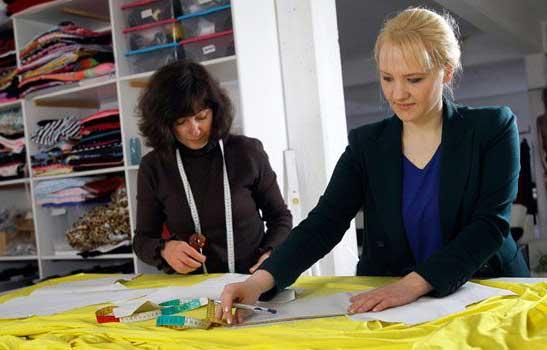| Videos | • Latest |
|
• Feature | • Sports | • Your Videos |
German designer creates clothing from milk

 0 Comment(s)
0 Comment(s) Print
Print E-mail
CNTV, November 19, 2011
E-mail
CNTV, November 19, 2011
Lady Gaga did it with bacon, countless designers have tried newspaper, but making clothing from milk is another challenge altogether. Now a German designer has achieved just that - and she's attracting interest from buyers as far away as Brazil and Australia.
Designer Anke Domaske insists her fabric doesn't smell, or have to be kept in the refrigerator, although it is almost entirely made from milk.
When the 28-year-old German set out to design a new textile, her aim was to make a fabric that would be sustainable in the long term and soothing to the skin of people suffering from allergies.
The textile, called "Qmilch" was developed by Domaske, a biochemist who is also a fashion designer. So far she has only used it to make dresses for her own MCC fashion line. But next year Domaske has plans to begin mass producing the threads that are made entirely from milk that would otherwise be poured down the drain.
|
|
|
In this photo taken Tuesday, Nov. 8, 2011, German fashion designer Anke Domaske, right, and seamstress Tatjana Berthold, left, work at their studio in Hannover, Germany. |
Already the fabric is making waves.
Domaske received the innovation award from Germany's Textile Research Association that recognized Qmilch - a combination of the word "Quality" and the German word for "milk" - as a new, sustainable fibre. It could revolutionize an industry currently heavily dependent on byproducts from oil, or natural resources such as the thousands of liters of water used to produce cotton.
The quest for a natural, non-irritating fabric originally drove Domaske to explore the use of milk protein, or casein.
Anke Domaske, fashion designer, said, "We only used natural raw materials, no chemicals, this is special. And the entire process to produce the fiber takes only one hour and a maximum of two liters of water. At the moment it is difficult for people with allergies to find the right cloth as most of the products are made with pesticides. Our product is a pure organic product and that's why I hope it will help people will allergies to feel comfortable."
After two years of trial and error, Domaske and her team finally landed on a complex process of reducing milk to a protein powder that is then boiled and pressed into strands that can be woven into a fabric.
The strands, she says, can be spun rougher for a heavier texture, or shiny smooth, to create a soft jersey that drapes and feels like silk.
Anke Domaske said, "A textile fiber needs to be washable and ironable. It was a challenge for us to find the right consistency. During the production process the fiber needs to be smooth like silk, but when we had it smooth, it wasn't water resistant, and when it was water resistant it wasn't smooth. It was a real challenge."
The young designer, who works from a loft beside the railway in the central German city of Hannover, has received queries from the German automobile industry that sees a potential for seat covers, members of the medical industry interested in a hypoallergenic material, as well as from dairy farmers as far away as Brazil and Australia who see Qmilch as a way to make good use of the milk they are forced to dispose of every day.







Go to Forum >>0 Comment(s)